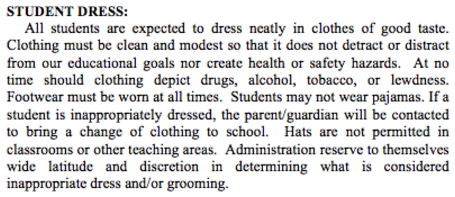“No Cheeks” are No Problem, Unless You’ve Read the Student Dress Code
By Larissa Aquaviva

Dress code in the Student Handbook. Photo by Larissa Aquaviva.
A dress code is implemented in order to make a learning environment safe and comfortable for all students; however, when a dress code is not communicated properly it can create major problems. This is an issue at Pascack Hills because some students are dressing under the “no cheek” rule and others under the official student handbook dress code. Students are left confused on what the dress code actually is and what is acceptable to wear at school. In order to stop this confusion, the school should put out a dress code that clearly states the rules and regulations of what a student can and cannot wear to school.
The dress code put in writing by the school is confusing in itself. For example, according to the student handbook, the rules under student dress state, “All students are to dress neatly in clothes of good taste.” The first sentence causes a dilemma for students in what is and what is not “good taste” making it hard for them to chose what to wear. The rules go on to state that hats cannot be worn in teaching areas and pajamas are not allowed. These rules could help Pascack Hills be a safe learning environment if all the students knew about it.
At our freshman orientation, we were told that the only dress code rules were the “no cheek” rule and that our clothing could not promote drug or alcohol use or violence. From the start of the school year, we have been dressing under these rules which lead us to dressing “neatly in clothes of good taste;” however, this leaves us in the dark about multiple other rules that some might say are a given to not wear to school. Yes, wearing pajamas to school is not a good idea and students should know hats are distracting in the classroom, but when some students do not directly think of the effects it has on other students, this could lead to them dressing against the written dress code.
Freshman Jess Gudin said, “If I got dress coded, I would be pretty upset because it was made clear to me that if my cheeks are covered, I am okay. Tell me the rules and I will follow them, but do not misinform me on what to wear.”
Although no freshman has gotten in trouble with the dress code thus far, these consequences are imminent. Multiple freshman are not aware of the no hat rule and could get in trouble if they wore one in class. This could result in a warning or a detention, both leaving a large impact on one’s high school experience because of the worries that they have not been told rules that they need to know.
The lack of clear-cut rules put out for everyone causes confusion and needs to be addressed. The “no-cheek” rule freshman are now dressing to should be added to the student dress section of the handbook as a true regulation. The dress code in place now does work, through the assumption of students, but changes in communication need to be made in order for every student to have a clear understanding on how to dress when going to school.










































